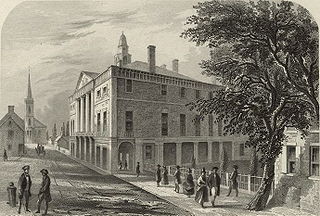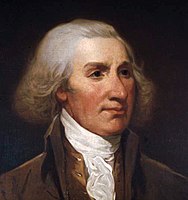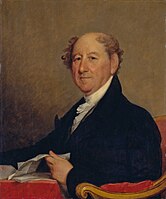Legislation
In February and March 1789, the 12th New York State Legislature (term 1788–89) [1] debated at length "An act for prescribing the times, places and manner of holding elections for Senators of the United States of America, to be chosen in this State", but the Anti-Federalist Assembly majority and the Federalist Senate majority could not agree, and they adjourned on March 3, without having elected U.S. senators. Both sides expected to win the State election in April.
On June 4, Governor George Clinton called an extra session [2] of the State Legislature to convene on July 6 at City Hall in Albany, New York. At the state election in April 1789, for a term beginning on July 1, a large Federalist majority had been elected to the New York State Assembly (65 members), estimated by State Senator James Duane at 42 to 22. The New York State Senate (24 members) continued with a slim Federalist majority.
The 13th New York State Legislature (term 1789–90) convened on July 6, and on July 11 passed "An act directing the manner of electing Senators to represent this State in the Senate of the United States", which required the election to be made by "concurrent vote" of both houses of the Legislature. This meant, if only one U.S. senator was to be elected, that each house nominated a candidate, and if both houses nominated the same person ("concurred"), the nominee was elected. If the Assembly nominated one, the Senate another, then the Senate's nominee was voted upon in the Assembly and the Assembly's nominee in the Senate; if none of the nominees was accepted by the other house, the proceedings started at the beginning. If two U.S. senators were to be elected, and Assembly and Senate chose different nominees, then the Assembly should elect one of the two Senate nominees, and the Senate one of the two Assembly nominees, effectively leaving one seat to be filled by each house of the Legislature. [3]
On July 13, the law was submitted to the Council of Revision. On July 15, the Council objected to the law in two points:
- The Council argued that the choice of U.S. senators by the State Legislature, under the U.S. Constitution, did not require a state law, since the State Legislature does not act in its legislative capacity, and the U.S. senators may be chosen simply by concurrent resolution. On the other side, if the U.S. senators were appointed by a state law passed by the State Legislature, the Council of Revision could object to the appointees, forcing to demand a two-thirds majority to overcome the Council's veto.
- The Council also took exception to the splitting of the seats in the case of two vacancies which would lead to one or both of the U.S. senators being elected contrary to the wishes of one or both of the houses of the State Legislature.
Thus the law was vetoed, and the State Legislature was left to fill the seats without written rules. In practice, the Assembly and the Senate separately took a vote, and if the winner in both houses was the same, he was declared elected. If Assembly and Senate chose different persons, the houses met for a joint ballot, which occurred for the first time in 1802.
Election and aftermath
On July 16, after the Council of Revision had vetoed the law, State Senator Philip Schuyler and Assemblyman Rufus King, two Federalists, were appointed to the U.S. Senate by a joint resolution of both houses of the State Legislature. King took his seat on July 25, and drew the lot for Class 3, his term expiring on March 3, 1795. Schuyler took his seat on July 27, and drew the lot for Class 1, his term expiring on March 3, 1791. The 1st United States Congress convened at New York City, as did the regular session of the New York State Legislature in January 1790. Schuyler retained his seat in the State Senate while serving concurrently in the U.S. Senate. [4] Schuyler was also elected on January 15 a member of the State's Council of Appointments, which consisted of the governor of New York and four state senators elected annually by the State Assembly. On January 27, the New York State Legislature resolved that it was "incompatible with the U.S. Constitution for any person holding an office under the United States government at the same time to have a seat in the Legislature of this State", and that if a member of the State Legislature was elected or appointed to a federal office, the seat should be declared vacant upon acceptance. Thus U.S. Senator Schuyler, Federal Judge James Duane and Congressmen John Hathorn and John Laurance vacated their seats in the State Senate. On April 3, John Cantine, a member of the Council of Appointments, raised the question if Schuyler, after vacating his State Senate seat, was still a member of the Council. Philip Livingston, another member, held that once elected a member could not be expelled in any case. On April 5, Governor Clinton asked the State Assembly for a decision, but the latter refused to do so, arguing that it was a question of law, which could be pursued in the courts. Schuyler thus kept his seat in the Council of Appointments until the end of the term. [5]

The 1st United States Congress, comprising the United States Senate and the United States House of Representatives, met from March 4, 1789, to March 4, 1791, during the first two years of George Washington's presidency, first at Federal Hall in New York City and later at Congress Hall in Philadelphia. With the initial meeting of the First Congress, the United States federal government officially began operations under the new frame of government established by the 1787 Constitution. The apportionment of seats in the House of Representatives was based on the provisions of Article I, Section 2, Clause 3, of the Constitution. Both chambers had a Pro-Administration majority. Twelve articles of amendment to the Constitution were passed by this Congress and sent to the states for ratification; the ten ratified as additions to the Constitution on December 15, 1791, are collectively known as the Bill of Rights, with an additional amendment ratified more than two centuries later to become the Twenty-seventh Amendment to the United States Constitution.
The Council of Appointment was a body of the Government of New York that existed from 1777 to 1822.

The 1791 United States Senate election in New York was held on January 19, 1791, by the New York State Legislature to elect a U.S. Senator to represent the State of New York in the United States Senate. The election was conducted by a system of approval voting.
The 1795 United States Senate election in New York was held on January 27, 1795 by the New York State Legislature to elect a U.S. Senator to represent the State of New York in the United States Senate.

The 1797 United States Senate election in New York was held on January 24, 1797, by the New York State Legislature to elect a U.S. Senator to represent the State of New York in the United States Senate. Incumbent Senator Aaron Burr's name was not placed into nomination for a second term. Former Senator Philip Schuyler was elected.

The first 1798 United States Senate special election in New York was held on January 11, 1798, by the New York State Legislature to elect a U.S. Senator to represent the State of New York in the United States Senate.

The second 1798 United States Senate special election in New York was held on August 17, 1798, by the New York State Legislature to elect a U.S. Senator to represent the State of New York in the United States Senate.

The first 1800 United States Senate special election in New York was held on April 3, 1800, by the New York State Legislature to elect a U.S. Senator to represent the State of New York in the United States Senate.
The second 1800 United States Senate special election in New York was held on November 6, 1800, by the New York State Legislature to elect a U.S. Senator to represent the State of New York in the United States Senate.
The 1801 United States Senate election in New York was held on January 27, 1801, by the New York State Legislature to elect a U.S. Senator to represent the State of New York in the United States Senate.
The 1802 United States Senate special election in New York was held on February 9, 1802, by the New York State Legislature to elect a U.S. Senator to represent the State of New York in the United States Senate.

The 1803 United States Senate election in New York was held on February 1, 1803, by the New York State Legislature to elect a U.S. Senator to represent the State of New York in the United States Senate.

The 1813 United States Senate election in New York was held on February 2, 1813, by the New York State Legislature to elect a U.S. Senator to represent the State of New York in the United States Senate.

The 1790–91 United States Senate elections were held on various dates in various states. These U.S. Senate elections occurred during the first midterm election cycle, which took place in the middle of President George Washington's first term. As these elections were prior to the ratification of the Seventeenth Amendment in 1913, senators were chosen by state legislatures. Senators were elected over a wide range of time throughout 1790 and 1791, and a seat may have been filled months late or remained vacant due to legislative deadlock. In these elections, terms were up for the nine senators in Class 1.

The 1890–91 United States Senate elections were held on various dates in various states. As these U.S. Senate elections were prior to the ratification of the Seventeenth Amendment in 1913, senators were chosen by state legislatures. Senators were elected over a wide range of time throughout 1890 and 1891, and a seat may have been filled months late or remained vacant due to legislative deadlock. In these elections, terms were up for the senators in Class 3.

The 1788–89 United States Senate elections were the first U.S. Senate elections following the adoption of the Constitution of the United States. They coincided with the election of George Washington as the first president of the United States. As these elections were prior to the ratification of the Seventeenth Amendment in 1913, senators were chosen by state legislatures.

The 12th New York State Legislature, consisting of the New York State Senate and the New York State Assembly, met from December 11, 1788, to March 3, 1789, during the twelfth year of George Clinton's governorship, in Albany.

The 13th New York State Legislature, consisting of the New York State Senate and the New York State Assembly, met from July 6, 1789, to April 6, 1790, during the thirteenth year of George Clinton's governorship, first in Albany, then in New York City.

The 14th New York State Legislature, consisting of the New York State Senate and the New York State Assembly, met from January 5 to March 24, 1791, during the fourteenth year of George Clinton's governorship, in New York City.

The 15th New York State Legislature, consisting of the New York State Senate and the New York State Assembly, met from January 5 to April 12, 1792, during the fifteenth year of George Clinton's governorship, in New York City.








